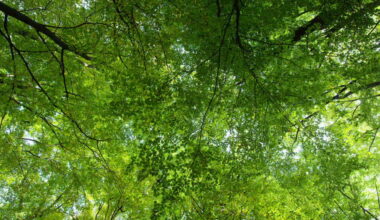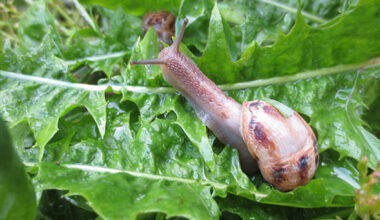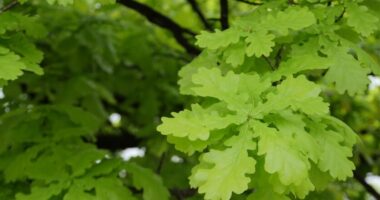That leaves get colored and fall off is not a plant fantasy: it is an adaptation to survive the winter cold. Indeed, in the fall, when the first frosts arrive and the season change, the tree must set up a system to live in slow motion during the winter.
Contents
Why do leaves change color with the seasons?
From spring to early fall, the leaves of the trees are green. Chlorophyll – which means “green leaf” in Greek – is a very abundant pigment during leaf growth in summer. Involved in photosynthesis, which converts sunlight into energy and organic matter, chlorophyll absorbs blue and red radiation from the sun and gives the leaves that green hue.
In autumn, however, there is less sunshine and temperatures drop. Trees begin to go dormant. Deprived of sunlight, their metabolism slows down and photosynthesis stops. The forests then reveal shades of warm colors produced by pigments already present in the leaves: xantophylls yellow the leaves of the trees while carotenes give them an orange color.
Trees adapt to the changing seasons
In autumn, the trees enter a phase known as paradormance. They prepare to face winter, which takes them a little over a month. If they lose their leaves, it is to limit the evaporation of water, which however will continue in a very limited way throughout the winter, and not to give frost hold in the woody tissues. As soon as frost arrives, the water supply to the leaves is stopped. Thus deciduous trees and shrubs no longer absorb water when the first frost periods arrive and winter can surprisingly be considered a dry season for them.
Coniferous trees with scales or needles have foliage covered with an insulating cuticle that limits the effects of evapotranspiration. As long as the temperature is above 0°C, photosynthesis continues, so they do not lose their foliage, which is called evergreen.
Some deciduous tree species will keep their dried leaves on the branches until the following spring. This is particularly the case for beeches and oaks. Their leaves are said to be marcescent.
The tree is a very complex living organism, capable of modifying its internal structure and external appearance according to the seasons and climate. We still have a lot to learn from this amazing plant.
How does leaf loss work when season change?
This phenomenon is triggered by two events:
- Decrease in sunshine time
- Falling temperatures
The surface of each sheet has receptors that indicate each of these two parameters. At a certain threshold, the sheet produces a compound called ethylene that will cause the sap supply to the sheets to stop using a small cork (yes, the same cork that is used to make the corks of wine bottles!).
The sap bringing all the nutrients does not reach the leaves anymore. The leaves will survive for some time on their reserves. Then, they will dehydrate and harden and they will eventually fall off. They are deciduous leaves.
At the same time, the compounds in the leaf will also degrade. Chlorophyll, the pigment that gives the green color to the leaves, also degrades! Thus other pigments degrading less quickly take over. Among them are carotenes, which give an orange-yellow color to the leaves.
What are the factors that trigger leaf fall in autumn?
Within a few days each year, the leaves on the trees start to fall: it’s like the trees are programmed! At least in all regions where the seasons differ from one another by obvious temperature differences. The alarm signal is therefore given by the following factors:
- the shortening of the days ;
- lower temperatures.
These changes trigger a chemical reaction in the sheet, a true solar collector: it begins to produce a surplus of ethylene. This phenomenon, comparable to a message sent to the tree by the leaf, will lead to a series of responses, namely :
- The tree starts to produce cork particles like small corks whose role is to prevent the sap from continuing to feed the leaves through their peduncles.
- The mechanism of photosynthesis is then blocked since the leaves no longer receive water or mineral salts. Chlorophyll can no longer be produced. This explains why in autumn, the leaves are no longer green but take on their autumn colors yellow, red, ochre.
- It takes only a few days for the leaves to die, dry out and fall off.
Once the tree is completely rid of its leaves, only its vital organs can continue to benefit from its sap throughout the winter. In this way, the tree ensures its survival.
Are all trees losing their leaves seasonally?
No, not all trees lose their leaves. Conifers such as spruce, cedar or pine have much more resistant leaves. These leaves are called evergreens!
Their surface area is significantly reduced and they come in the form of needles or scales. A small surface area makes them less exposed to the cold and wind, which could easily dehydrate them.
In addition, a thin layer of wax protects them from the freezing temperatures of winter.
Summary
Trees lose their leaves for a simple reason: they adapt to the cold. In winter, trees live in slow motion. The trunk protected by the bark and the roots in the “warm” soil are not afraid of the harshness of winter. The leaves have no means of protection and therefore do not resist the cold.








